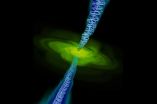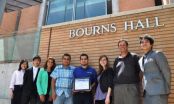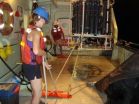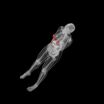(Press-News.org) A new study of supermassive black holes at the centers of galaxies has found magnetic fields play an impressive role in the systems' dynamics. In fact, in dozens of black holes surveyed, the magnetic field strength matched the force produced by the black holes' powerful gravitational pull, says a team of scientists from the U.S. Department of Energy's Lawrence Berkeley National Laboratory (Berkeley Lab) and Max Planck Institute for Radio Astronomy (MPIfR) in Bonn, Germany. The findings are published in this week's issue of Nature.
"This paper for the first time systematically measures the strength of magnetic fields near black holes," says Alexander Tchekhovskoy, the Berkeley Lab researcher who helped interpret the observational data within the context of existing computational models. "This is important because we had no idea, and now we have evidence from not just one, not just two, but from 76 black holes."
Previously, Tchekhovskoy, who is also a postdoctoral fellow at the University of California, Berkeley, had developed computational models of black holes that included magnetic fields. His models suggested a black hole could sustain a magnetic field that was as strong as its gravity, but there was not yet observational evidence to support this prediction. With the two forces balancing out, a cloud of gas caught on top of the magnetic field would be spared the pull of gravity and instead levitate in place.
The magnetic field strength was confirmed by evidence from jets of gas that shoot away from supermassive black holes. Formed by magnetic fields, these jets produce a radio emission. "We realized that the radio emission from black holes' jets can be used to measure the magnetic field strength near the black hold itself," says Mohammad Zamaninasab, the lead author of the study, who did the work while at MPIfR.
Other research teams had previously collected radio-emission data from "radio-loud" galaxies using the Very Long Baseline Array, a vast network of radio telescopes in the United States. The researchers analyzed this pre-existing data to create radio-emission maps at different wavelengths. Shifts in jet features between different maps let them calculate the field strength near the black hole.
Based on the results, the team found not only that the measured magnetic fields can be as strong as a black hole's gravity, but that they are also comparable in strength to those produced inside MRI machines found in hospitals--roughly 10,000 times greater than the field of the Earth itself.
Tchekhovskoy says the new results mean theorists must re-evaluate their understanding of black-hole behavior. "The magnetic fields are strong enough to dramatically alter how gas falls into black holes and how gas produces outflows that we do observe, much stronger than what has usually been assumed," he says. "We need to go back and look at our models once again."
INFORMATION:
Lawrence Berkeley National Laboratory addresses the world's most urgent scientific challenges by advancing sustainable energy, protecting human health, creating new materials, and revealing the origin and fate of the universe. Founded in 1931, Berkeley Lab's scientific expertise has been recognized with 13 Nobel prizes. The University of California manages Berkeley Lab for the U.S. Department of Energy's Office of Science. For more, visit http://www.lbl.gov.
Surprisingly strong magnetic fields challenge black holes' pull
Analysis of radio waves from black holes shows long-neglected magnetic fields have an unexpected presence
2014-06-04
ELSE PRESS RELEASES FROM THIS DATE:
No evidence of the double nature of neutrinos
2014-06-04
Neutrinos are tiny, neutral elementary particles that, contrary to the standard model of physics, have been proven to have mass. One possible explanation for this mass could be that neutrinos are their own antiparticles, so-called Majorana particles.
Though experimental evidence for this is still lacking, many theoretical extensions of the standard model of physics predict the Majorana nature of neutrinos. If this hypothesis proves to be true, many previously unanswered questions about the origin of our universe and the origin of matter could be answered.
650 meters ...
NASA sees Depression Boris mOVING over Mexico with heavy rainfall
2014-06-04
Tropical Depression 2E strengthened into Tropical Storm Boris briefly on June 3 before making landfall in southern Mexico and weakening into a depression. While Boris was building to tropical storm strength, NASA's Aqua and TRMM satellites passed overhead identifying heavy rainfall and the extent of the storm.
On June 3 at 19:15 UTC (3:15 p.m. EDT) the Moderate Resolution Imaging Spectroradiometer (MODIS) instrument aboard NASA's Aqua satellite captured a visible image of Tropical Storm Boris over Central America. Boris appeared circular in the imagery and its clouds ...
Scientist uses fossils to prove historic Ohio millstones have French origins
2014-06-04
Cleveland . . . A geologist studied fossils to confirm that stones used in 19th century Ohio grain mills originated from France. Fossils embedded in these millstones were analyzed to determine that stones known as French buhr were imported from regions near Paris, France, to Ohio in the United States.
Dr. Joseph Hannibal, curator of invertebrate paleontology at The Cleveland Museum of Natural History, was lead author on research published in the Society for Sedimentary Geology journal PALAIOS.
The study documents a technique that uses fossils to definitively distinguish ...
Cleaning the air with roof tiles
2014-06-04
RIVERSIDE, Calif. (http://www.ucr.edu) — A team of University of California, Riverside's Bourns College of Engineering students created a roof tile coating that when applied to an average-sized residential roof breaks down the same amount of smog-causing nitrogen oxides per year as a car driven 11,000 miles.
They calculated 21 tons of nitrogen oxides would be eliminated daily if tiles on one million roofs were coated with their titanium dioxide mixture. They also calculated it would cost only about $5 for enough titanium dioxide to coat an average-sized residential roof.
That ...
Mayo Clinic researchers decode how the brain miswires, possibly causing ADHD
2014-06-04
JACKSONVILLE, Fla. — Neuroscientists at Mayo Clinic in Florida and at Aarhus University in Denmark have shed light on why neurons in the brain's reward system can be miswired, potentially contributing to disorders such as attention deficit hyperactivity disorder (ADHD).
They say findings from their study, published online today in Neuron, may increase the understanding of underlying causes of ADHD, potentially facilitating the development of more individualized treatment strategies.
The scientists looked at dopaminergic neurons, which regulate pleasure, motivation, ...
GW Cancer Institute conducts survey on moving toward quality patient-centered care
2014-06-04
WASHINGTON (June 4, 2014) — In order to meet new cancer program accreditation standards, institutions have placed new focus on patient navigation, psychosocial distress screening, and survivorship care plans. Recently published research by the George Washington University (GW) Cancer Institute found these new programs are experiencing "growing pains." The results of a nationwide survey conducted by the GW Cancer Institute and reviewed in the Journal of Oncology Navigation and Survivorship, found that health care professionals could most benefit from greater evaluation of ...
Hemorrhagic fevers can be caused by body's antiviral interferon response
2014-06-04
LA JOLLA, CA—June 4, 2014— Hemorrhagic fevers caused by Lassa, dengue and other viruses affect more than one million people annually and are often fatal, yet scientists have never understood why only some virus-infected people come down with the disease and others do not.
But now, virologists and immunologists at The Scripps Research Institute (TSRI) have found a major clue to the mystery of "hemorrhagic fever" syndromes. In findings reported this week in an Early Edition of the Proceedings of the National Academy of Sciences, the team showed that Interferon Type I (IFN-I) ...
Astronomers discover first Thorne-Zytkow object, a bizarre type of hybrid star
2014-06-04
In a discovery decades in the making, scientists have detected the first of a "theoretical" class of stars first proposed in 1975 by physicist Kip Thorne and astronomer Anna Żytkow. Thorne-Żytkow objects (TŻOs) are hybrids of red supergiant and neutron stars that superficially resemble normal red supergiants, such as Betelguese in the constellation Orion. They differ, however, in their distinct chemical signatures that result from unique activity in their stellar interiors.
TŻOs are thought to be formed by the interaction of two massive stars―a ...
How red tide knocks out its competition
2014-06-04
New research reveals how the algae behind red tide thoroughly disables – but doesn't kill – other species of algae. The study shows how chemical signaling between algae can trigger big changes in the marine ecosystem.
Marine algae fight other species of algae for nutrients and light, and, ultimately, survival. The algae that cause red tides, the algal blooms that color blue ocean waters red, carry an arsenal of molecules that disable some other algae. The incapacitated algae don't necessarily die, but their growth grinds to a halt. This could explain part of why blooms ...
New diagnostic imaging techniques deemed safe in simulations
2014-06-04
DURHAM, N.C. -- Gamma and neutron imaging offer possible improvements over existing techniques such as X-ray or CT, but their safety is not yet fully understood. Using computer simulations, imaging the liver and breast with gamma or neutron radiation was found to be safe, delivering levels of radiation on par with conventional medical imaging, according to researchers at Duke Medicine.
The findings, published in the June issue of the journal Medical Physics, will help researchers to move testing of gamma and neutron imaging into animals and later humans.
Conventional ...
LAST 30 PRESS RELEASES:
Early relapse predicts poor outcomes in aggressive blood cancer
American College of Lifestyle Medicine applauds two CMS models aligned with lifestyle medicine practice and reimbursement
Clinical trial finds cannabis use not a barrier to quitting nicotine vaping
Supplemental nutrition assistance program policies and food insecurity
Switching immune cells to “night mode” could limit damage after a heart attack, study suggests
URI-based Global RIghts Project report spotlights continued troubling trends in worldwide inhumane treatment
Neutrophils are less aggressive at night, explaining why nighttime heart attacks cause less damage than daytime events
Menopausal hormone therapy may not pose breast cancer risk for women with BRCA mutations
Mobile health tool may improve quality of life for adolescent and young adult breast cancer survivors
Acupuncture may help improve perceived breast cancer-related cognitive difficulties over usual care
Nerve block may reduce opioid use in infants undergoing cleft palate surgery
CRISPR primes goldenberry for fruit bowl fame
Mass General Brigham announces new AI company to accelerate clinical trial screening and patient recruitment
Fat tissue around the heart may contribute to greater heart injury after a heart attack
Jeonbuk National University researcher proposes a proposing a two-stage decision-making framework of lithium governance in Latin America
Chromatin accessibility maps reveal how stem cells drive myelodysplastic progression
Cartilaginous cells regulate growth and blood vessel formation in bones
Plant hormone allows lifelong control of proteins in living animal for first time
Swedish freshwater bacteria give new insights into bacterial evolution
Global measures consistently underestimate food insecurity; one in five who suffer from hunger may go uncounted
Hidden patterns of isolation and segregation found in all American cities
FDA drug trials exclude a widening slice of Americans
Sea reptile’s tooth shows that mosasaurs could live in freshwater
Pure bred: New stem cell medium only has canine components
Largest study of its kind highlights benefits – and risks – of plant-based diets in children
Synergistic effects of single-crystal HfB2 nanorods: Simultaneous enhancement of mechanical properties and ablation resistance
Mysterious X-ray variability of the strongly magnetized neutron star NGC 7793 P13
The key to increasing patients’ advance care medical planning may be automatic patient outreach
Palaeontology: Ancient tooth suggests ocean predator could hunt in rivers
Polar bears may be adapting to survive warmer climates, says study
[Press-News.org] Surprisingly strong magnetic fields challenge black holes' pullAnalysis of radio waves from black holes shows long-neglected magnetic fields have an unexpected presence







